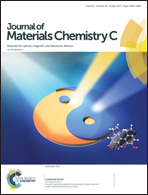Tunable magnetic pole inversion in multiferroic BiFeO3–DyFeO3 solid solution†
Abstract
In ferromagnets, the magnetic moment can generally be reversed by applying a sufficiently high external magnetic field of opposite polarity. Temperature, on the other hand, is usually known to affect only the magnitude of a magnetic moment, rather than its sign or polarity (most magnets exhibit a monotonic increase in magnetization upon cooling below their magnetic phase transition temperature). As a result, temperature-induced magnetization reversal (i.e. magnetic pole inversion) remains a very rare phenomenon which lacks proper understanding and explanation because of the extreme difficulties encountered in controlling the thermodynamics of magnetization of classical metal or metal oxide magnets. Herein, we report an unusual magnetic pole inversion behaviour in multiferroic (1 − x)BiFeO3–xDyFeO3 solid solution (alloy), which can be tuned by varying the concentration of the magnetic ion Dy3+ in the solid solution. It is found that the temperature-induced magnetic pole inversion occurs in a wide composition range (x = 0.14–0.90). Moreover, for the first time in any ferrites, multiple magnetic pole inversions are observed in the solid solution compounds of high Dy3+-concentrations. Our results may provide a better understanding of the temperature- and composition-induced magnetic pole inversion and related phenomena and point to new potential applications for magnetic and multiferroic materials.



 Please wait while we load your content...
Please wait while we load your content...